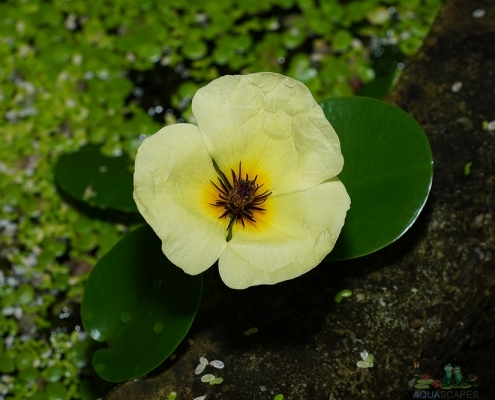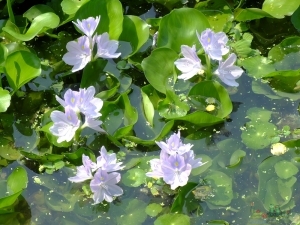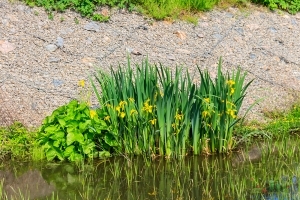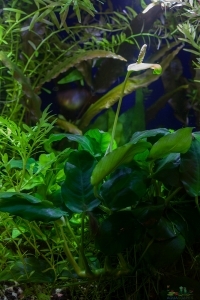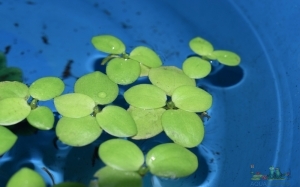10 Popular Pond Plants
Welcome to the first part of an introduction to popular pond plants. As you can see, there are many different aquatic plants that you can use in your backyard pond to improve its beauty and create a relaxing atmosphere for yourself and visitors.
I’m going to talk about 10 plants that are suitable for small ponds or auxiliary containers. These plants have very common names so I will also provide their official scientific names to be able to search them on the internet without any problems.
Water Lilies (Nymphaea sp.)
Water lilies belong to the family of nympheacae, which form floating leaves supported by water until they grow tall enough not to touch the water surface anymore. All water lily species like warm weather conditions of spring and summer. They are not suitable for winter because of their tropical origin of which temperatures are above 50 degrees Fahrenheit.
You can place water lilies in the center or side of your pond, at least 2 to 3 feet away from each other to avoid overcrowding. These plants actually require a lot of free space on top of the water surface so they can grow wide leaves without shading themselves out. After spending some time growing roots submerged on the bottom of your pond, they will be able to grow taller with minimal support from you, just keep an eye on them while placing rocks over their tangled roots.
Water lilies have beautiful flowers that usually come in colors such as white, pink, purple…etc But these flowers have very short life spans and they only bloom for a few days. If you want to enjoy their beauty longer, you can cut off their flowers before they dry out and place them in water inside a vase.
Similar Looking to Water Lillies
The following aquatic plants look very similar to water lilies:
Water Poppy ( Hydrocotyle sibthorpioides ) – You will notice that this plant has round leaves, it’s because it’s not an actual water lily but the stems of its leaves are floating just above the surface while its roots stay submerged on the bottom of your pond. It likes full sunlight conditions so keeping both conditions at optimal levels will help it grow better. You can divide this plant into smaller pieces to keep your small ponds full with enough flora.
It likes warm weather conditions, so if you place it in a container that is not heated then you must move the container inside during wintertime. This plant will be able to grow very tall, so if you want it to look like water lilies but with smaller leaves just cut off any part of its stem when it grows tall enough and prepare soil inside the pot for them; they will start growing new roots immediately.
Water Forget-Me-Not ( Ludwigia sp.) – It’s actually one of my favorite plants because of its beautiful appearance and fast growth rate when I first planted them in my containers 3 years ago.
This plant has round leaves and it’s very suitable for small ponds because of its small height. It looks very similar to water lilies when it grows, but its flowers are pink in color which will match with the color of your pond if you have one that matches too.
Like water poppy, it can grow roots submerged on the bottom or above the surface depending on how you keep it, but don’t worry about giving this plant too much care because it doesn’t mind anything at all! I sometimes forget to give them some sunlight by keeping my container inside a place where there is no window nearby, but they still do fine for many months before they need any attention again. Just make sure you never over-water this plant; if you see the leaves of this plant start drooping even for a little bit while they are still green then it means you have already over-watered them and they need time to dry out.
Water Hyacinth ( Eichornia crassipes )
This beautiful aquatic plant has thin stems that rise from the water surface covered by shiny round leaves with deep space in between each other. Its flowers turn into small pods filled with seeds that can be used for propagation if you like to grow more plants on your own.
Water hyacinths like calm waters, so ponds with fish or any creatures inside will not be suitable for their life. They don’t require much care compared to other container plants of its kind because it will still look beautiful without any extra help. However, be aware that because it can grow roots submerged on the bottom of your pond, you must never plant them inside a container that is not standing on top of bricks or rocks to prevent them from drowning.
Anacharis (Elodea canadensis)
 After spending some time growing roots submerged under the surface, this plant will start rising tall stems covered by small round leaves which are very similar to water lilies but smaller. There are many types of anacharis plants because they have been grown for different purposes all over the world; sometimes they have flowers while others don’t.
After spending some time growing roots submerged under the surface, this plant will start rising tall stems covered by small round leaves which are very similar to water lilies but smaller. There are many types of anacharis plants because they have been grown for different purposes all over the world; sometimes they have flowers while others don’t.
Anacharis has pointed leaves so it’s very suitable for fish ponds where your fish will be able to hide inside the leaves if they feel scared of you. It also prevents ammonia levels in your pond to become too high because it’s actually one of the best plants you can use to absorb them!
Anacharis is great for beginners, but make sure you never let this plant dry out or else it will start decaying and lose its beautiful appearance. Its roots are very sensitive so don’t move them with bare hands; always wear gloves when taking care of anacharis plants (this rule applies to all aquatic plants unless they are hardy).
Parrot Feather (Myriophyllum aquaticum)
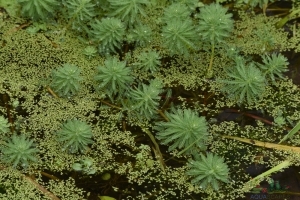 You have probably seen this plant sold inside pet shops where they often call it ‘Frogbit’ instead. Parrot feather is a very common plant in the aquarium world but some people also use them on their ponds too.
You have probably seen this plant sold inside pet shops where they often call it ‘Frogbit’ instead. Parrot feather is a very common plant in the aquarium world but some people also use them on their ponds too.
Its leaves are long and thin, so unless you have a small container this plant may take all the space of your pond! Its roots will become fine looking grass under proper care which looks beautiful on its own for your pond while growing taller stems above the surface covered by glossy green leaves that look like feathers from a parrot’s chest.
You can buy this plant at any garden center or fish shop, but don’t forget to bring it home with you after buying because there are many stores out there that sell them as aquatic plants not knowing they can live on dry land too.
Yellow Iris (Iris pseudacorus)
This is another great container plant which you can keep inside your pond if the water level is not over its leaves; otherwise it will start growing taller stems that rise above the surface too like parrot feather used to do. I made this mistake when I first started keeping them, but after cutting their thick roots several times they became small enough to be kept inside my container again.
Yellow iris has shiny long green leaves with bright yellow flowers rising on top of them in spring time followed by new thick roots during summer while turning into seeds in autumn where they eventually fall off and grow brand new plants.
Yellow iris is the most popular plant in this list with an upright habit, so I recommend you to try growing them even if your pond isn’t covered by water all year around. Just bring some pots inside during winter and place them next to warm windows with lit light bulbs above them (you can also use small LED lamps for this purpose).
Parrot’s Beak (Alisma subcordatum)
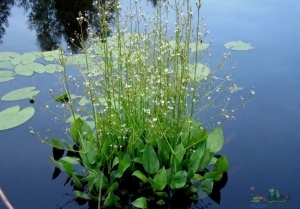 This is another beautiful plant for your garden ponds which you can’t find anywhere else because its flowers are only sold inside pet shops.
This is another beautiful plant for your garden ponds which you can’t find anywhere else because its flowers are only sold inside pet shops.
Parrot’s beak has long shiny green leaves with dark spots made of raised dots on them that resemble parrots’ beaks. The plant remains smaller than other container plants so it won’t take much room from the surface. It also doesn’t grow too much roots underneath, so if your pond isn’t very deep this would be a good choice to try.
Water Celery (Oenanthe javanica)
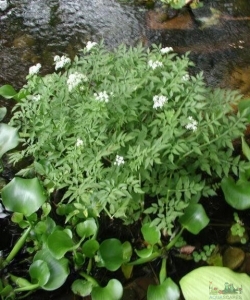 This tropical plant was brought to Europe as an aquarium plant many years ago and now it’s sold as a pond plant too.
This tropical plant was brought to Europe as an aquarium plant many years ago and now it’s sold as a pond plant too.
Water celery is very easy to grow like all other anacharis plants which you can buy at any garden center or fish shop; the only difference between them is that water celery has thicker leaves and doesn’t climb on rocks like anacharis does. The leaves’ color changes from light green in summer time to dark red during autumn where they eventually fall off revealing new ones before winter comes.
Anubias Barteri
This beautiful African plant was brought to Europe as an aquarium plant, but it’s actually a tropical forest water-lily! That means if you want it to live during summer time outside your pond you need to bring some pots inside.
Anubias has large dark green leaves with rhizomes growing underneath them that can be planted into your substrate or even attached to pieces of rocks if you don’t plan on planting them directly in the ground. This plant likes calm waters and will do well if your pond is big enough so all leaves can get covered by water at least one third of their length, but too much sunlight will burn their thin edges so remember this when growing anubias!
Amazon Frogbit (Limnobium laevigatum)
This plant may seem like water lily because its leaves are round, but they have little holes in them which is a good indicator to identify them from water lilies.
Amazon frogbit is very popular among fish keepers because its roots stay on the top of the substrate while its leaves create a perfect hiding place for some species of fish. This plant likes calm water and will do well if your pond has enough space so all plants can get covered by water more than half of their length. The more light it gets, the faster it grows!
Thanks for reading at Meyer Aquascapes! We hope you’ve enjoyed our post on garden pond design. Please leave a comment below if you liked it or have any questions. We’d love to hear from you! Thanks for stopping by!


